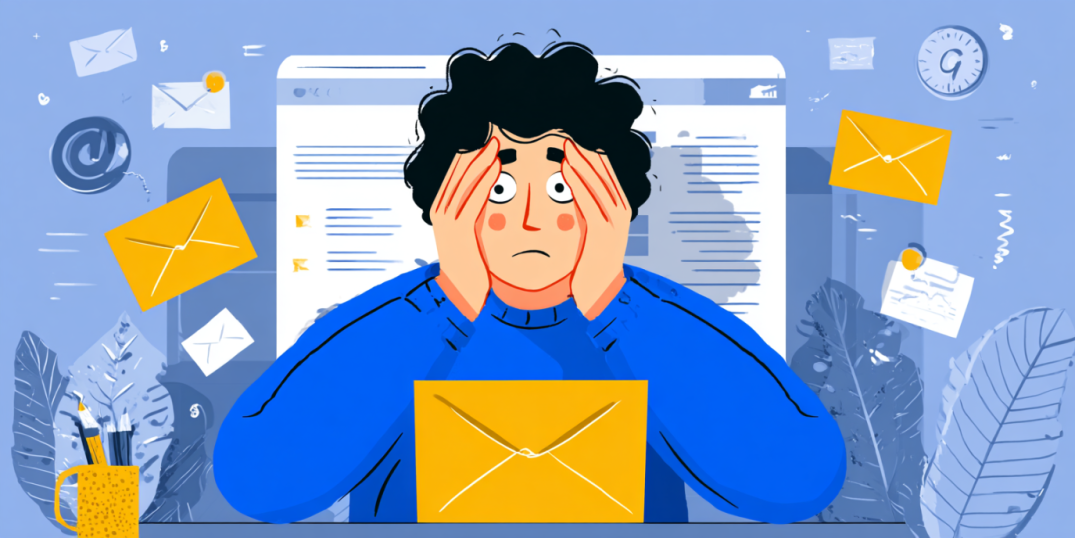- Home
- Email Tips and Tricks
- Unprofessional Email Examples ...

“ Hey girl! Saw your post on LinkedIn and figured I’d reach out to you. I think my latest product could be super helpful to you, we focus on writers like you who are trying to monetize their articles. Sounds good to you? Let’s have a call later today!” That was a message I once received on LinkedIn and which stuck with me not because of its offer, but because of how inappropriate it sounded.
Emails like this are the equivalent of harassing somebody on the street or strolling into a business meeting wearing a stained T-shirt and talking loudly on the phone. However, they are more common than one might think: typos, overly informal wording, unclear intent, or complete lack of personalization. There are many examples of bad emails out there, and we all receive them from time to time.
In this article, we will talk about unprofessional emails and showcase some poorly written email examples. We will also offer some easy and valuable tips on how to avoid sounding unprofessional when it comes to email etiquette.
Characteristics of Unprofessional Emails
There are many types of emails out there—business updates, cold outreach, internal memos, marketing emails. Each has its own logic, structure, and purpose. And yet, when emails fail, they often fail because of the same root cause. And this shared root cause of so many unprofessional emails isn’t a typo or a weak subject line, but the absence of intention. What does that mean?
An email with no clear intent doesn’t know who it’s talking to. There’s no sense of audience, no tone that has a specific reader in mind. That’s how we end up with messages that are oddly vague or inappropriately casual.
Lack of intention also means there’s no structure—just a blur of sentences hoping to impress everyone at once and no one in particular. In most cases the outcome varies between confusing and negative: the recipient reads the message and walks away without clarity or intention for further interaction.
On top of that, without intention:
⚠️ Subject lines become meaningless or even misleading
⚠️ The body of the message becomes either cluttered or empty
⚠️ The tone shifts in the wrong direction
⚠️ The sign-off loses all coherence—sometimes too stiff, sometimes too relaxed, sometimes both
While these signs of poorly written emails seem like many different parts, they all trace back to the sender that never paused to ask, “Why am I writing this, and who am I writing it for?”
Impact on Professional Reputation
What makes unprofessional emails truly damaging isn’t the fact that they’re poorly written—it’s that they slowly chip away at your professional reputation.
A single vague subject line might be forgiven. So might a casual tone or an abrupt ending. But when these signs of poor email etiquette appear repeatedly, they begin to form a pattern. And in a professional context, patterns become identity. So, with time, a co-worker might turn into a “guy without manners” and a brand into “a company that doesn’t respect its clients.”
So, what happens when these nasty labels stick? Colleagues start removing your messages before acting on them, while subscribers discard your emails before opening them.
In most cases professional credibility and a solid reputation are achieved not through outstanding performance, but through the everyday rhythm of communication. When that rhythm falters, so does your reputation. Emails can have a big impact on that reputation, and if you want it to be positive, learning how to write with intent is a skill to learn.
Examples of Unprofessional Emails
Business communication

Breakdown of what went wrong
Subject line
When you see a new email in your inbox titled “hey there,” it doesn’t signal “professional update” to your brain. And for a good reason. Instead of setting expectations or previewing the topic, this subject line imitates a greeting. It does what a greeting does—just in the wrong place. It’s also lowercase, non-specific, and casual to the point of feeling almost disrespectful, which is a big no-go for a business email.
Greeting
Actually, there isn’t one—because “Hi Mark” decided to show up where the subject line should have been. There’s also no “Good morning,” or “Hello,” in this unprofessional email example. It just jumps straight into the body. In casual conversation, that might be forgivable (though still not ideal). But in business communication, skipping the greeting reads more like being simply unaware of basic etiquette.
Body of the message
The words themselves are perfectly reasonable. The tone isn’t. Phrases like “just checking in,” “no big issues,” or “grab a drink?” belong more in a friendly group chat than a professional thread of communication. These are all red flags of poor email etiquette.
Signature
“Cheers, John” sounds like a friendly personal note. But this isn’t a friendly personal note—it’s meant to be a professional update, which makes it awkward and inappropriate.
Tips what could be improved
🔷 A subject line should preview the purpose, not open with a shrug.
🔷 Add a greeting—it’s a small step that adds structure and respect.
🔷 Keep your body purposeful: what’s the update, what’s the action, why does it matter?
🔷 Save social gestures (like drinks) for a separate email or a different medium.
🔷 Stick to a more professional signature with contact details.
Marketing email

Breakdown of what went wrong
Overall structure and visual overload
When you open an offer like this, the first feeling you get is disorientation and chaos. What’s this email about? Who is it for? You have no idea—instead, you’re hit with a wall of visuals, competing fonts, and floating product links. It looks much more like a collage than a message that must guide you towards a certain action.
Lack of personalization
Not a single name, segment, or hint that this was sent to a real person. It looks and feels like a mass email that tried to pack everything in, hoping that someone finds any of it attractive. Considering the importance of personalization for contemporary marketing, this one shows all signs of poor email etiquette.
Call to action overload
“Shop June Hitlist,” “Shop Summer,” “Shop Festival Collection,” “Shop Bikini Basics”—you’re being asked to click on four different things before you’ve even figured out what this email is trying to say. The CTAs here compete for attention rather than guide you through a funnel.
What could be improved?
🔷 Start with a clear message and let the design guide it through the copy.
🔷 Personalize, at least a little, by adding a greeting or a subject line that actually connects.
🔷 Simplify your CTAs and make them focus on one hero product.
🔷 Use hierarchy and whitespace—your reader will thank you for it.
Cold email outreach

Breakdown of what went wrong
No personalization beyond the name
A good cold email is an unexpected guest in people’s mailboxes, so it shall explain the context for reaching out. Mention where you found them (“I came across your profile on LinkedIn…”), what caught your attention, or how it relates to what you offer.
Assumes need without context
“I assume you might be looking to scale…” is one of the weakest lines in the whole email. Cold outreach already has a conversion rate around 1%—so you can’t afford to guess. You have to base your messaging on real research. What does the company do? What stage are they in? What challenge might they be facing? If you don’t know, don’t write yet.
Vague offering
“We specialize in various digital solutions…” says almost nothing. A better email would narrow in on one clear value: “We help early-stage teams automate manual workflows without hiring extra developers.”
No proof or credibility
“We’ve worked with companies across different industries and seen great success.” Which companies? What kind of success? In cold emails, credibility needs to be earned quickly. One stat, one client name—whatever, but you have to give your recipients something.
What could be improved?
🔷 Personalize beyond the name—mention how you found the person or why you’re reaching out to them specifically.
🔷 Avoid assumptions—use observable facts instead.
🔷 Add credibility—include one line of proof, like a result or past client.
🔷 Write a subject line with purpose.
To Sum Up
In this article, we showcased different unprofessional email examples. While many things can be done wrong in an email—starting from a subject line and ending with a signature—one thing that unites all poorly written emails is the lack of intent.
And it’s exactly this lack of intent that leads to emails becoming impersonal, vague, or overwhelming. While you can correct your typos with autocorrect, if you write an email that’s addressed to nobody, the result will be disappointing.
So, try to start by asking yourself: “Who is my target audience?” “What are their needs—and how can my product help solve them?” By having a clear intent, you lay a foundation where there’s substantially less room left for unprofessionalism.



